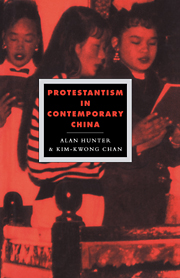Book contents
- Frontmatter
- Contents
- List of figure and tables
- General editors's preface
- Acknowledgements and notes on the text
- List of abbreviations
- Map
- Introduction
- 1 The social and political context
- 2 A survey of the Protestant community
- 3 The historical legacy
- 4 Protestantism and Chinese religious culture
- 5 Varieties of Christian life
- 6 Buddhism and Catholicism
- 7 Into the 1990s
- Bibliography
- Index
1 - The social and political context
Published online by Cambridge University Press: 04 May 2010
- Frontmatter
- Contents
- List of figure and tables
- General editors's preface
- Acknowledgements and notes on the text
- List of abbreviations
- Map
- Introduction
- 1 The social and political context
- 2 A survey of the Protestant community
- 3 The historical legacy
- 4 Protestantism and Chinese religious culture
- 5 Varieties of Christian life
- 6 Buddhism and Catholicism
- 7 Into the 1990s
- Bibliography
- Index
Summary
1949–1979: THE PARTY TRIUMPHANT
In October 1949 the CCP announced the foundation of the People's Republic of China. The next three years saw the high point of popular support for the new government, but the situation soon became more tense with the outbreak of the Korean war when the Chinese people were called on to ‘aid Korea and resist the US’ by means of voluntary military service, financial contributions and massive demonstrations. At the same time the CCP stepped up its efforts to revolutionize China: not content to rule, the communists intended to transform Chinese society. This entailed expropriation of the capitalist class and the creation of an egalitarian society through ideological campaigns, thought reform, public accusation meetings, mass arrests and intensive social control. All industries were nationalized by the mid-1950s and thereafter ran on command lines adopted from the Soviet Union, China's main ally. The state was effectively a one party system, with the theory of proletarian dictatorship as its ideological justification. There was undoubtedly repression, but also progress: China finally freed herself of foreign control, and standards of public health, education and welfare improved.
There were parallel developments in the countryside. By 1952 most land had been redistributed, in the following years it was collectivized and by 1958 People's Communes were set up over most of China. They remained in operation until the early 1980s, the evidence suggesting that they were inefficient as production units, although they did have a number of advantages over family farming:
- Type
- Chapter
- Information
- Protestantism in Contemporary China , pp. 21 - 65Publisher: Cambridge University PressPrint publication year: 1993



